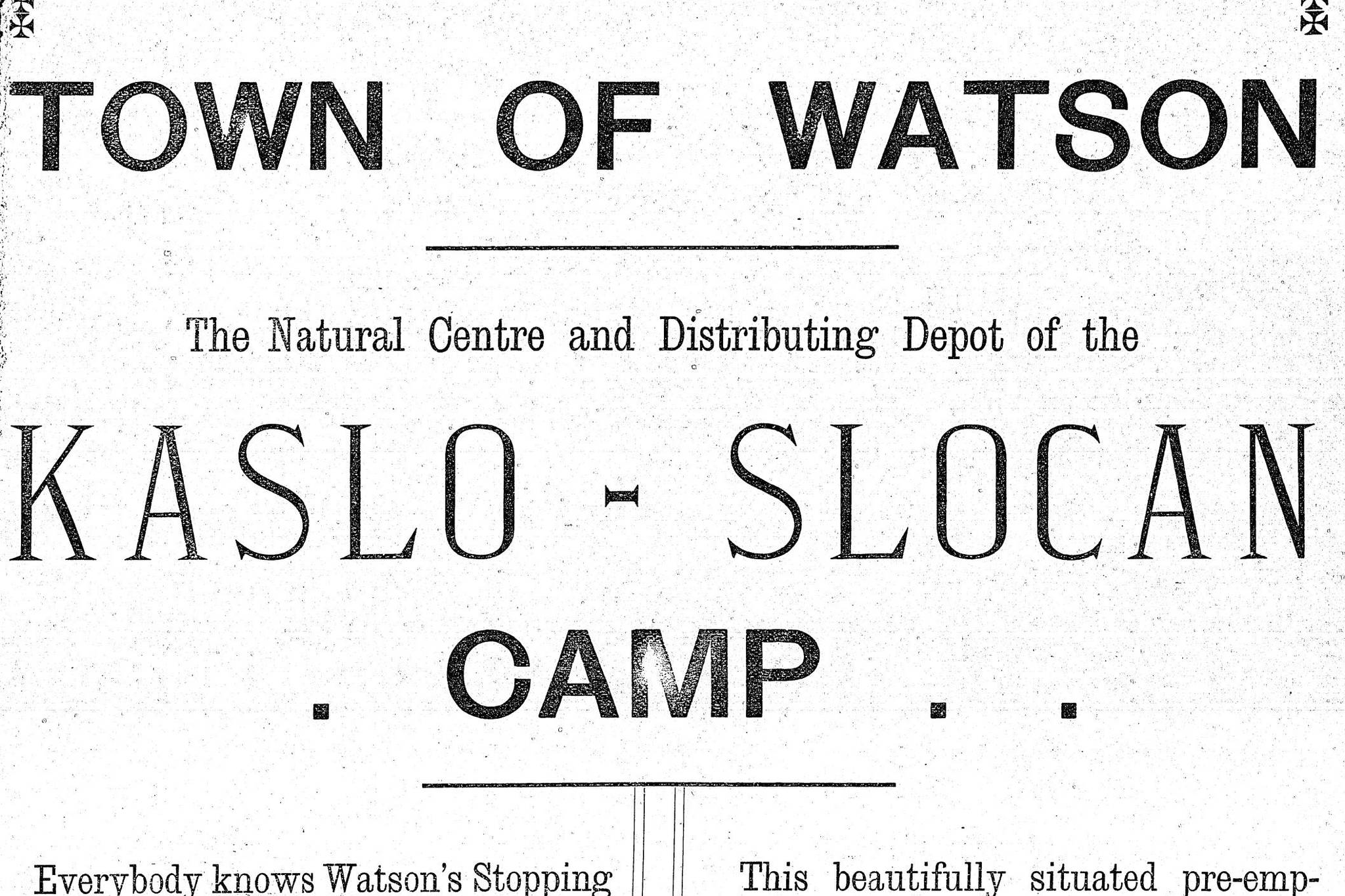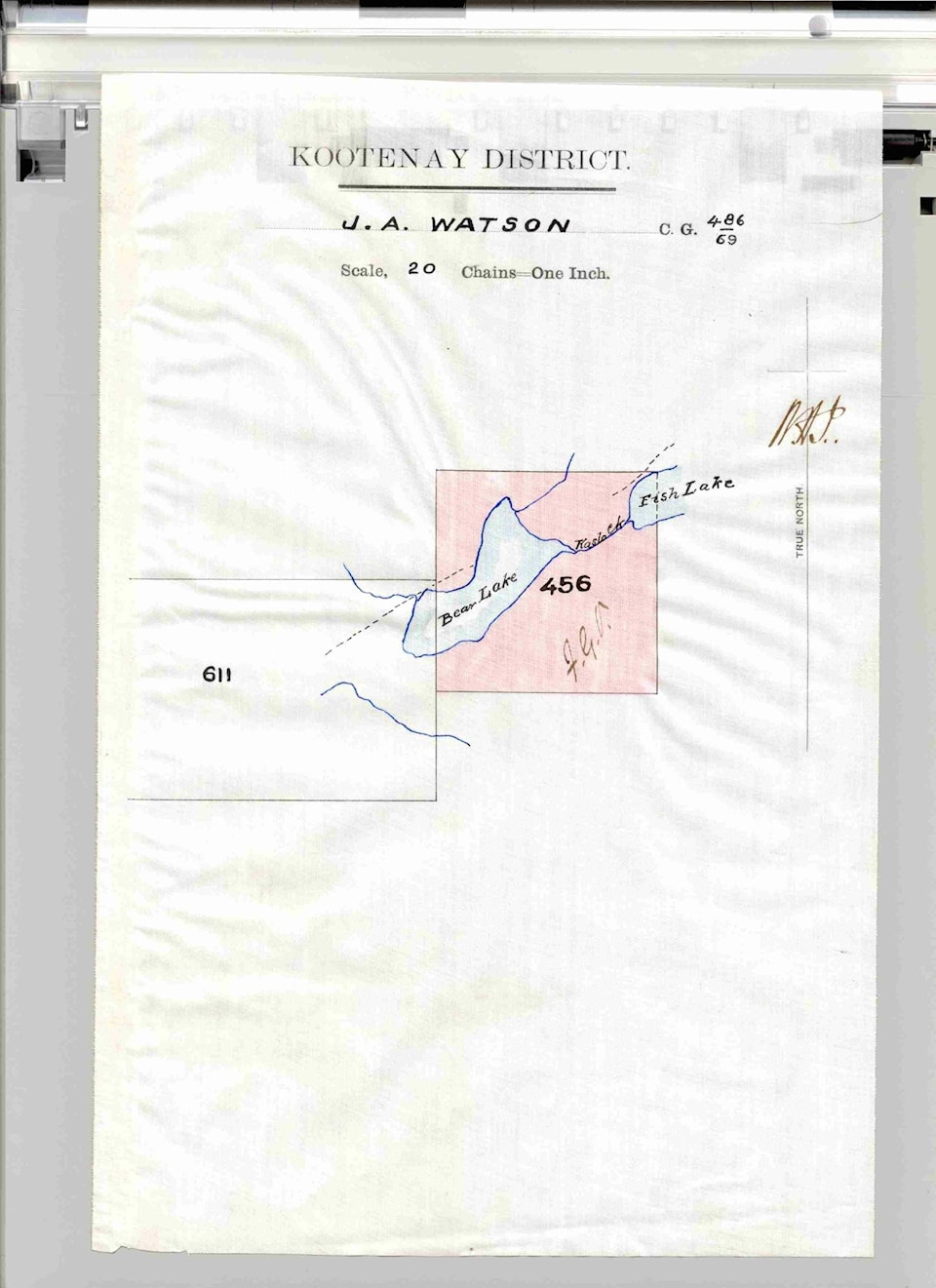Two hundred seventh in an alphabetical series on West Kootenay/Boundary place names
Watson, or Watsonville, was an early townsite in the Slocan, named for its founder, John Adam Watson (1860-1923).
Watson was born in Glasgow and immigrated to Canada in 1882. He worked on railway construction gangs and as a CPR clerk in Swift Current, Medicine Hat, and Donald, near Golden.
In 1890, he joined a Geological Survey of Canada party mapping the mountains around Kootenay Lake. Impressed with the country, he and fellow Scot David Bremner bought a livery at Ainsworth and began hauling ore from the local mines. When the Silvery Slocan rush began in the fall of 1891, Watson joined in.
On Oct. 26 he applied for 320 acres near the junction of Carpenter and Seaton creeks — the future site of Three Forks. However, while his notice appeared in the Nelson Miner, it didn’t show up in the official BC government gazette. Before he realized this, Eli Carpenter applied for the same property — but it became a moot point when the government reserved all land within ten miles of Slocan Lake.
On May 4, 1892, Watson applied to buy what became Lot 456, including much of Bear Lake and part of Fish Lake. In between them, he envisioned a townsite. He and Bremner established a halfway house and store and he applied for a Crown grant for a mining claim called the Central City.
The town was first mentioned by an anonymous correspondent to the Spokane Review of July 9, 1892: “[W]e were soon trudging along toward Bear and Fish lakes … where a camp known as Central City has been pitched on a strip of land between the two lakes. It has a population of about 200.”
Sometime that month Watson decided the town would be better off with his own name.
H.W.C. Jackson wrote in the Spokane Review of Aug. 11: “Watsonville, B.C., Aug. 2 – The new town which has sprung up at Bear and Fish lakes on the summit of the low pass between Kaslo and Seaton creeks is now pretty generally known by the above style and title.”
J.A. Kirk surveyed the Watson townsite. The streets were named Payne, Kootenay, Kaslo, Watson, and Moody. A full page ad that first appeared in the Nelson Miner on Oct. 22, 1892 called Watson the “Natural Centre and Distributing Depot of the Kaslo-Slocan Camp” and claimed “Everybody knows Watson’s Stopping Place at Bear Lake, where Prospectors and Miners have made their headquarters since the beginning of the Slocan excitement.” Lots were offered at $75 and $100. John L. Retallack was the real estate agent.
An application for a post office at Watson was referred to the postal inspector on Nov. 11, 1892. It opened June 13, 1893 with merchant E.R. Atherton as postmaster. The civic directory listed 30 names, including five hotelkeepers and many miners and mine owners.
In a letter to his aunt dated Jan. 16, 1893, Watson wrote: “I … am now, in company with Mr. Bremner, the owner of what may yet become almost a second Denver … Should the supply of silver emanating from the mines keep coming out in the way it has been doing, nothing can keep us back, and my town of ‘Watson’ is right in the heart of this mining country.”
Unfortunately for him, something could and did keep him back. On July 25, 1894 — 19 days after he obtained a Crown grant for Lot 456 — a forest fire leveled Watson and nearby Bear Lake City. The Nelson Tribune wrote: “The town of Watson was made up of about 20 frame and log buildings and cabins. Watson’s hotel, Clark’s restaurant, Black’s hotel, and Atherton’s store were the principal business houses. The total loss at Watson and the sawmill about half a mile from the town cannot be far from $20,000.”
The Ledge added: “At Bear Lake and Watson the inhabitants had to get out on logs in the lake until the atmosphere on shore became bearable. Some took refuge in Atherton’s fire proof, covering the entrance with wet blankets. This cellar was all right and Atherton saved most of his goods.”
Watson wrote to his fiancee in Scotland: “Yesterday a bush fire swept through the country and completely destroyed my little town as well as several other places. I am plumb afoot now and shall have to rustle a job … Watson was completely gutted and of course besides losing three good buildings, the standing of the place has been considerably hurt, thereby materially affecting the condition of my pocket book.”
The post office stayed open until the end of September, at which point Atherton resigned and moved to Sandon. John Watson’s plans to resume selling lots and rebuild his namesake town didn’t get very far. The only new building was a hotel erected by Lot Willey (which itself burned in 1897).
Watson negotiated instead with the Kaslo and Slocan Railway to buy his townsite, since their line was expected to pass through it. It’s not known what deal they struck. The 1897 civic directory indicated Watson was a station along the line, but it wasn’t on the first timetable issued in 1895, which used the name Bear Lake instead.
John Watson went back to work for the Geological Survey, then returned to Scotland to marry Alice Mary Harrison Clarke. By 1900, they settled in Victoria, where they lived the rest of their lives.
While his own town was a bust, Watson later helped lay out the Prince Rupert townsite. His name also lives on in Watson Creek, which flows into Bear Lake. It was first mentioned in the Nelson Miner of June 18, 1892.
In 2002, Watson’s grandson, John Spencer Church, published A Young Scotsman’s Adventures in Canada, which transcribed Watson’s surviving correspondence from 1882 to 1901.

